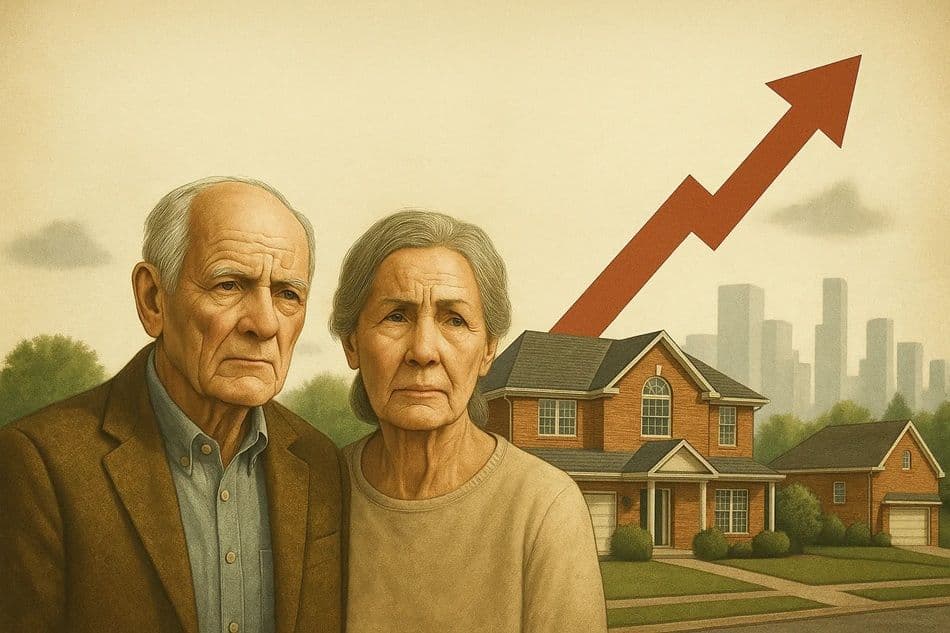Ask GRAI Anything
Your Real Estate Questions, Answered Instantly via Chat


Help us make GRAI even better by sharing your feature requests.

Every property boom in history has rested on one silent assumption: that tomorrow will have more buyers than today.
But as the world gets older, that assumption is quietly collapsing.
Population growth - the oxygen of real estate - is slowing, reversing, or stagnating across the developed world. And that shift is no longer a future problem. It’s reshaping prices, yields, and even the very purpose of housing right now.
The United Nations projects that by 2030, one in six people globally will be aged 60 years or over, up from one in eleven in 2000.
The median global age will climb from 30.1 to 36 years by 2050.
That may sound modest - until you realize what it means for demand velocity.
In Japan, nearly 30% of the population is already over 65.
In Germany, 23%.
In Italy, 20%.
Even in the United States, where immigration once offset aging, the median age has reached 39, the highest in U.S. history.
And fertility?
South Korea: 0.68 births per woman - the lowest ever recorded anywhere.
China: population down 2 million in 2024, marking the second straight year of decline.
EU average: 1.46, well below replacement rate.
When fewer children are born, and fewer young workers enter the housing ladder, the entire ecosystem - from mortgages to construction - begins to age out.
Also Read: The 50-Year Mortgage: How It Could Reshape Real Estate
Housing markets depend on constant churn: new buyers replacing old ones, families expanding, urban centers renewing.
As societies age, that churn slows.
Demand shrinks
Fewer first-time buyers, more empty-nesters, more single-person households.
Supply overshoots
Developers keep building based on past population projections - flooding markets that no longer have the demographic depth to absorb new inventory.
Values stagnate
Homes stop appreciating because fewer people are competing for them.
We’re already seeing early warning signs:
Japan: In rural prefectures, homes are selling for under $20,000 - less than the cost of demolition - as demand evaporates.
Italy: Roughly 20% of all housing stock now sits vacant, much of it in depopulating towns.
China: Once driven by speculative demand, its property sector now faces demographic headwinds; by 2035, 30% of Chinese citizens will be over 60.
Real estate in aging countries is shifting from a growth asset to a yield asset - more like a bond than a stock.
Must Read: China’s Property Meltdown: A Global Real Estate Risk You
The demographic squeeze intersects with monetary reality in a brutal way.
Older populations tend to:
Spend less and save more.
Resist debt and large purchases.
Favor stability over growth.
That’s toxic for property cycles that rely on credit expansion.
In the U.S., for example, mortgage issuance among under-35 buyers is down 19% since 2020, while refinancing among seniors has surged 34%.
Aging economies also generate lower inflation - and by extension, lower nominal returns.
Even when property prices rise, they often trail overall cost-of-living growth, eroding real yields.
In Japan, property values in many regions are flat or negative in real terms - despite decades of ultra-low interest rates.
The demographic divide will increasingly split global real estate markets into “ageing yielders” and “young growers.”
| Region | Median Age (2025) | Population Growth (2020–2030) | Real Estate Outlook |
|---|---|---|---|
| Japan | 49.8 | -4.9% | Stagnant to declining; urban rental stability only |
| Germany | 45.5 | -0.8% | Aging core cities; strong healthcare property demand |
| U.S. | 39.0 | +4.2% (mainly immigration-driven) | Regional divergence; Sunbelt resilience |
| India | 29.1 | +15% | Long-term expansion; infrastructure-driven boom |
| Indonesia | 30.4 | +9.5% | Young labor base; mid-income housing growth |
| UAE | 31.6 | ≈ +24% (immigration-led) | High demand tied to migrant inflows |
| Brazil | 34.7 | +3.8% | Slow growth; rising affordability pressure |
Younger economies - especially those combining urbanization + immigration + tech adoption - will see stronger rent and price appreciation through 2035.
Older economies will pivot toward yield, income stability, and adaptive reuse (retrofitting old housing stock into healthcare and multi-generational living spaces).
As demographics harden, investors will have to abandon the “rising tide” logic that defined property since WWII.
Instead, returns will hinge on resilience, not growth.
Here’s where capital is rotating:
Senior living & healthcare real estate: From assisted care to medical office parks, demographic demand is non-cyclical.
Multi-generational housing: Especially in Europe and East Asia, families consolidating into shared ownership will reshape urban footprints.
Emerging-market housing: India, Vietnam, the Philippines, and Kenya are now the world’s last major buyer-driven housing frontiers.
Adaptive reuse & rental platforms: In the West, conversion of underused assets (offices, retail) into affordable rentals will define the next decade.
The greatest opportunity isn’t in fighting aging - it’s in designing for it.
Governments often treat aging as a healthcare or pension issue. But in reality, it’s a land use crisis in disguise.
As populations shrink, infrastructure costs per capita soar. Cities will need fewer new homes - but smarter ones. Tax revenues will fall even as maintenance costs rise.
Japan’s local governments are already experimenting with “compact cities” - intentionally shrinking their geographic footprint to sustain public services. Europe is beginning to follow suit.
By the early 2030s, Western housing markets may need policy support similar to renewable energy - subsidies not to expand, but to repurpose and preserve value.
GRAI’s simulation models can forecast how demographic curves translate into property outcomes - demand, yield, and appreciation risk - across multiple time horizons.
Try:
“Forecast home price appreciation under aging population scenarios.”
“Compare yield profiles between aging vs young economies.”
“Model urban depopulation effects on city-level housing markets.”
“Simulate 2035 real-estate values under UN population forecasts.”
Model your property returns with GRAI : https://internationalreal.estate/chat
GRAI doesn’t just interpret data - it helps investors, analysts, and policymakers see how time itself compounds or erodes value.
Demographics move slowly - until they don’t.
And when they turn, they reshape the foundation of every property cycle.
In the next decade, real estate will diverge not by architecture or amenity, but by age. Young nations will build wealth.
Old nations will preserve it.
For investors who can see the shift early - and model it intelligently - the coming demographic squeeze isn’t a threat.
It’s the new frontier of strategy.